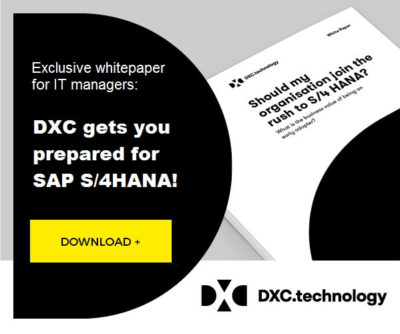How to migrate to SAP S/4HANA? This DXC Whitepaper you should know
Digital added value and real-time analysis of all processes in a company are becoming increasingly important in the age of digitization with Scandinavian countries as the EU frontrunners. The new SAP S/4HANA ERP suite combines both, and it’s gaining more and more attention from SAP regular and new customers. The migration to SAP S/4HANA seems to be rather complex. How to succeed in it and why “early adopters” are getting more out of it, you will learn from this exclusive DXC whitepaper.
This article is addressed to:
- Large companies which want to speed up their processes and start new business models.
- CIOs who want to renew the existing SAP landscape and make it “cloudable” in line with the overall digital transformation.
- CEOs who want to gain real-time insight into all company processes in order to react quickly to changes and implement new initiatives or ideas.
With the idea of offering compressed air as a service, Kaeser Kompressoren from Coburg, Germany, became a major talking point worldwide. Via real-time analysis the mid-sized company is able to monitor all of its compressed air systems delivered worldwide and to collect several million measurements per day.
Most importantly: Kaeser can predict any technical disruption at any time and help its customers in the run-up to a potential failure. DXC has provided the tools for the new system by migrating the SAP Business Suite to several HP App Systems for SAP HANA.
By the way: Use cases like this have made DXC technolgy one of the top technology and service providers in Germany according to the SAP Hana Vendor Benchmark 2017 and to the SAP HANA ranking of the Experton Group. This is also the result of more than 30 years of SAP partnership with today more than 9,500 specialists in the field.
Migrating an existing environment to the new SAP S/4HANA solution represents a major technological challenge for companies of all types, according to a PAC survey.
DXC accompanies organizations all through the profitability analysis and the conception to the implementation and last adjustments on the way to a successful SAP S/4HANA transformation.
This shows an infographic and a DXC whitepaper with the title: “Should my organization join the rush to S/4HANA? What is the business value of being an early adopter?”
How your company benefits from the digitization and the deployment of SAP S/4HANA, you can read in the current whitepaper from DXC!
Download now for free!
Advantages and benefits of the new ERP suite
SAP sees S/4HANA as the new “digital core product” for all businesses. Other than the SAP HANA in-memory database platform alone, the new ERP suite is able to interlink the digital processes of all business areas and to integrate the business networks.
Thus the Internet of Things (IoT) and Industry 4.0 come into play. In addition, SAP S/4HANA can be used in the form of SaaS (software as a services) or other cloud models or even on-premise with a company’s own resources.
As use cases for the new Business Suite S/4HANA, SAP mentions finance, business and financial planning, “Segment of One” targeting the customer as an individual, Material Requirements Planning (MRP), logistics, and the automotive industry. In the whitepaper mentioned above, DXC demonstrates additional benefits for enterprises, such as new supply chains and network models, and more flexibility through cloud services.
DXC offers S/4HANA both on-premise and as a cloud solution. As the two SAP specialists Rob Fletcher and Jörg Tischler explained in a PAC interview, the migration of the existing environment into the new S/4HANA solution represents the biggest technological hurdle, because it requires to customize different interfaces, applications and linked environments simultaneously.
The SAP HANA Cloud Platform (HCP) can be very useful in solving the problems, but it is not the only supported cloud platform. Cloud customers in Germany are supplied through the DXC data centers. For on-premise installations, customers can rely on Global Delivery Centers in Manila, Philippines, and India.
Why DXC could be an exciting partner for your migration to SAP S/4 HANA –
The most interesting information for Scandinavian businesses you will find in this free DXC Whitepaper.
A worthwhile journey
S/4HANA is built on the SAP HANA in-memory platform and is a valuable basis for the digitization and acceleration of business processes, supporting an wide range of solutions, such as Big Data, the Internet of Things (IoT), real-time analysis and mobility.
Despite the growing interest in S/4HANA, many German companies think that the effort and the related costs are difficult to predict, according to the PAC survey.
Finally, the migration also requires organizational rethinking, which requires that the management is actively involved. DXC has developed a so-called SHAPE methodology.
The SHAPE methodology incorporates a four-step roadmap, which starts with the business processes and consultation (Advise) in order to take the corporate customers on the journey.
You are looking for a way to SAP S/4 HANA which optimally meets your requirements?
The DXC Whitepaper provides first food for thoughts.
The four steps of the SHAPE roadmap:
Advise is the advisory or consultancy phase in which the advantages and the roadmap are determined. According to Tischler and Fletcher, most companies are still at this stage. DXC and SAP work closely with the respective teams at the business customers.
Transform is the “transformation phase” in which important adjustments are made to speed up the journey with regard to added value. This includes the deployment of a hybrid cloud and the secure migration of S/4HANA to DXC Helion, an OpenStack architecture for various cloud environments.
Manage is the phase for final adjustments to the application lifecycle management (ALM) and the operation of the solution as well as for for integrating S/4HANA into the and the transfer of the S/4HANA system into the running operation of the corporate customer.
Optimize is the final phase of optimizing processes and applications such as Big Data, as well as optimizing automations for app and cloud operations, to provide business users with lasting value.

Implementation – why and how?
According to the DXC infographic, 85 percent of respondents see the need for transformation towards a digital management. S/4HANA promises 30 to 40 percent lower implementation times and overall TCO costs.
Additionally: From 2025, support arrangements for older SAP products will be more expensive. Therefor it seems advisable to migrate to SAP projects in a timely manner.
After all, 38 percent of German companies surveyed by PAC have already done this or are planning to do so in the next two to four years. For early adopters in Germany, the acceleration of processes and data analysis and the modernization of SAP landscape are at the top of the list, according to the results of the PAC survey.
Whether and how the migration takes place is up to a company itself. For example, a gradual changeover to S/4HANA Finance can have advantages and disadvantages. According to the DXC whitepaper it can even mean that the migration becomes more difficult later on and the entire digital transformation will be delayed for an unnecessarily long time.
For this reason, DXC considers the entire SAP system landscape of a customer as a whole, in order to advise a long-term favorable transformation strategy.
Source title: South_agency / iStock
[plista]



